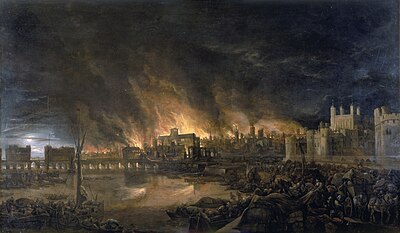
Back የሎንዶን ታላቅ ቃጠሎ Amharic حريق لندن الكبير Arabic Böyük London yanğını Azerbaijani لندنین بؤیوک یانقینی AZB Вялікі лонданскі пажар Byelorussian Пажар у Лёндане 1666 году BE-X-OLD Голям пожар в Лондон (1666) Bulgarian লন্ডনের মহাগ্নিকাণ্ড Bengali/Bangla Tan-gwall bras Londrez Breton Gran incendi de Londres Catalan


The Great Fire of London was a major conflagration that swept through central London from Sunday 2 September to Thursday 6 September 1666,[1] gutting the medieval City of London inside the old Roman city wall, while also extending past the wall to the west. The death toll is generally thought to have been relatively small,[2][3] although some historians have challenged this belief.[4]
The fire started in a bakery in Pudding Lane shortly after midnight on Sunday 2 September, and spread rapidly. The use of the major firefighting technique of the time, the creation of firebreaks by means of removing structures in the fire's path, was critically delayed due to the indecisiveness of the Lord Mayor, Sir Thomas Bloodworth. By the time large-scale demolitions were ordered on Sunday night, the wind had already fanned the bakery fire into a firestorm which defeated such measures. The fire pushed north on Monday into the heart of the City. Order in the streets broke down as rumours arose of suspicious foreigners setting fires. The fears of the homeless focused on the French and Dutch, England's enemies in the ongoing Second Anglo-Dutch War; these substantial immigrant groups became victims of street violence. On Tuesday, the fire spread over nearly the whole city, destroying St Paul's Cathedral and leaping the River Fleet to threaten Charles II's court at Whitehall. Coordinated firefighting efforts were simultaneously getting underway. The battle to put out the fire is considered to have been won by two key factors: the strong east wind dropped, and the Tower of London garrison used gunpowder to create effective firebreaks, halting further spread eastward.
The social and economic problems created by the disaster were overwhelming. Flight from London and settlement elsewhere were strongly encouraged by Charles II, who feared a London rebellion amongst the dispossessed refugees. Various schemes for rebuilding the city were proposed, some of them very radical. After the fire, London was reconstructed on essentially the same medieval street plan, which still exists today.[5]
Cite error: There are <ref group=lower-alpha> tags or {{efn}} templates on this page, but the references will not show without a {{reflist|group=lower-alpha}} template or {{notelist}} template (see the help page).
- ^ All dates are given according to the Julian calendar. Note that, when recording British history, it is usual to use the dates recorded at the time of the event. Any dates between 1 January and 25 March have their year adjusted to start on 1 January according to the New Style.
- ^ Cite error: The named reference
tindeathwas invoked but never defined (see the help page). - ^ Cite error: The named reference
porterdeathwas invoked but never defined (see the help page). - ^ Cite error: The named reference
Hanson 2001, 326–33was invoked but never defined (see the help page). - ^ Reddaway, 27
© MMXXIII Rich X Search. We shall prevail. All rights reserved. Rich X Search